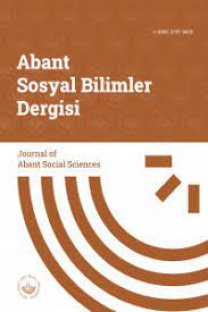Örgütsel Bağlılık, Örgütsel Vatandaşlık ve Örgütte Kalma Niyeti Arasındaki İlişki: Bunların Bazı Değişkenler Açısından İncelenmesi
Makale basılı kopyadan tarandığı için açılması bağlantı hızınıza göre farklılık gösterebilir. Makaleyi bilgisayarınıza indirmeniz tavsiye edilir.
Anahtar Kelimeler:
Bağlılık, Örgütsel Bağlılık, Duygusal Bağlılık, Devam
-
The opening speed of this scanned document may vary depending on your connection speed.
Keywords:
-,
___
- Allen, N. J., Grisaffe, D. B. (2001). “Employee Commitment to the Organization
- and Customer Reactions: Mapping the Linkages”, Human Resource
- Management Review. c. 11, n. 3.
- Allen, N. J., Meyer, J. P. (1990). “The Measurement and Antecedents of Affective, Continuance and Normative Commitment to the Organization”, Journal of Occupational Psychology. 11. 63.
- Bartlett, K. R. (2001). “The Relationship Between Training and Organizational Commitment: A Study in the Health Care Field”, Human Resource Development Quarterly. 0.12, n. 4.
- Bateman, T. S. , Organ, D. W. (1983). “Job Satisfaction and the Good Soldier: The Relationship Between Affect and Employee Citizenship”, Academy of Management Journal. n. 26.
- Becker, H. S. (1960). “Notes of the Concept of Commitment”, American Journal of Sociology. n. 66.
- Bergman, M. E. (2006). “The Relationship Between Affective and Normative Commitment: Review and Research Agenda”, Journal of Organizational Behavior. n. 27.’
- Blakely, G. L., Andrews, M.C. , Moorman, RH. (2005). “The Moderating Effects
- ,R of Equity Sensitivity on The Relationship Between Organizational Justice
- and Organizational Citizenship Behaviors”, Journal of Business and
- Psychology. 0. 20, n. 2.
- Brown, B. B. (2003). Employees’ Organizational Commitment and Their Perception of Supervisors’ Relations-Oriented and Task-Orientend Leadership Behoviors. Virginia.
- Brown, R. B. (1996). “Organizational Commitment: Clarifying the Concept and
- Simplifying the Existing Construct Typology”, Journal of Vocational Behavior. n. 49.
- DiPaola, M. F., Hoy, W. K. (2005). “Organizational Citizenship of Faculty and Achievement of High School Students”, The High School Journal. Feb/May.
- Gautam, T., Dick, R. V., Wagner, U., Upadhyay, N., Davis, A.J. (2005). “Organizational Citizenship Behavior and Organizational Commitment in Nepal”, Asian Journal of Social Psychology. n. 8.
- Gellatly, I. R., Meyer, J. P., Luchak, A. A. (2006). “Combined Effects of the Three Commitment Components on Focal and Discretionary Behaviors: A Test of Meyer and Herscovitch’s, Propositions”, Journal of Vocational Behavior. 0.69, n. 2.
- Irving, P., Coleman, D., Cooper, C. (1997). “Further Assessements of a Three— q. ÜLKER _. 247
- Orgütsel Bağlılık, Orgütsel Vatandaşlık ve Örgütte Kalma Niyeti. .. Component Model of Occupational Commitment: Generalizability and Differences Across Occupations”, Journal of Applied Psychology. c. 82, n. 3.
- İşcan, Ö. F., Naktiyok, A. (2004). “Çalışanların Örgütsel Bağdaşımlarının
- Belirleyicileri Olarak Örgütsel Bağlılık ve Örgütsel Adalet Algılan”, Ankara
- Üniversitesi. SBF Dergisi. c. 59, n. 2.
- Jaros, S. J. (1997). “An Assessment of Meyer and Allen’s (1991) Three
- Component Model of Organizational Commitment and Turnover Intentions”,
- Journal of Vocational Behavior. n. 51.
- KOSlOWSky, M. (1990). “Staff/Line Distinctions in Job and Organizational Commitment”, Journal of Occupational Psychology. n. 63.
- Lievens, F. , Anseel, F. (2004). “ConŞrmatory Factor Analysis and Invariance of an Organizational Citizenship Behaviour Measure Across Samples in a Dutch—Speaking Context”, Journal of Occupational and Organizational Psychology. n. 77.
- Mayer R. C., Schoorman, F. D. (1998). “Differentiating Antecedents of Organizational Commitment: A test of March and Simon’s Model”, Journal of Organizational Behavior. n. 19.
- McMurray, A. J., Scott, D. R., Pace, R. W. (2004). “The Relationship Between Organizational Commitment and Organizational Climate in Manufacturing”, Human Resource Development Quarterly. c. 15, n. 4.
- Meyer, J. P., Stanley, D. J., Herscovitch, L., Topolnytsky, L. (2002). “Affective, Continuance and Normative Commitment to the Organization: A Meta— Analysis of Antecedents, Correlates and Consequences”, Journal of Vocational Behavior. n. 61.
- Meyer, l., Allen, N. (1991). “A Three—Component Conceptualization of Organizational Commitmen ”, Human Resource Management Review. n. 1.
- Meyer, J. P., Herscovitch, L. (2001). “Commitment in the Workplace Toward a General Model”, Human Resource Management Review, n. ll.
- Mitchell, T. R., Larson, J.R. (1987). People in Organizations. An Introduction to Organizational Behavior. Third Edition McGraw-Hill.
- Mowday, R. T., Streets, R. , Porter, L.W. (1979). “The Measurement of Organizational Commitment”, Journal of Vocational Behavior. 11. 14.
- Mowday, R. T. ( 1998). “Reflections of the Study and Relevance of Organizational Comniitmen ”, Human Resource Management Review. c. 8. n. 4.
- Mottaz, C. J. (1987). “An Analysis of the Relationship Between Work
- Satisfaction and Organizational Commitment”, Sociological Quarterly. 0. 28. n. 4.
- O’Reilly, C. A., Chatman, J. (1986). “Organizational Commitment and
- Abant İzzet Baysııl Üniversitesi Sosyal Bilimler Enstitüsü Dergisi 200 7-1 (14)
- Psychological Attachment: The Effets of Compliance, IdentiŞcation and
- Internalization on Prosocial Behavior”, Journal of Applied Psychology. n. 71.
- Porter, L. W., Streers, R. M., Mowday, R. T., Boulian, P. V. (1974). “Organizational Commitment, Job Satisfaction and Turnover Among Psychiatric Technicians”, Journal of Applied Psychology. n. 59.
- Riketta, M. (2005). “Organizational IdentiŞcation: A Meta Analysis”, Journal of Vocational Behavior. c. 66, n. 2.
- Salancik, G. (1977). “Commitment is too easy ” Organizational Dynamics. n. 6.
- Schein. E. H., (Çev. Mustafa Tosun) (1978). Örgüt Psikolojisi. TODAİE Yayınları. 1 73. Ankara.
- Scholl, R. W. (1981). “Differentiating Commitment from Expectancy as a Motivating Force”, Academy of Management Review. n. 6.
- Schultz, D., Schultz, S. E. (2002). Psychology and Work Today. Eighth Ed. Prentice-Hall.
- Yayın Aralığı: Yılda 3 Sayı
- Başlangıç: 2000
- Yayıncı: Abant İzzet Baysal Üniversitesi Sosyal Bilimler Enstitüsü
